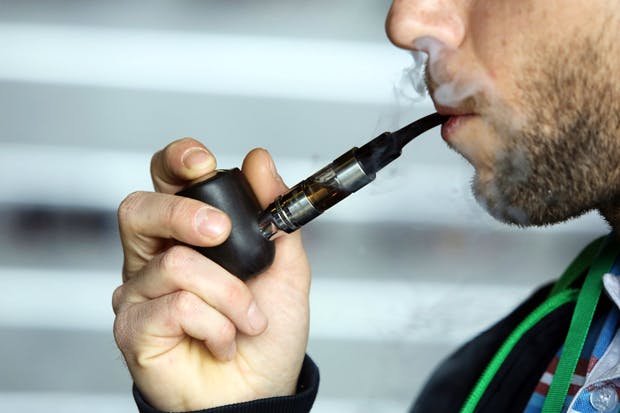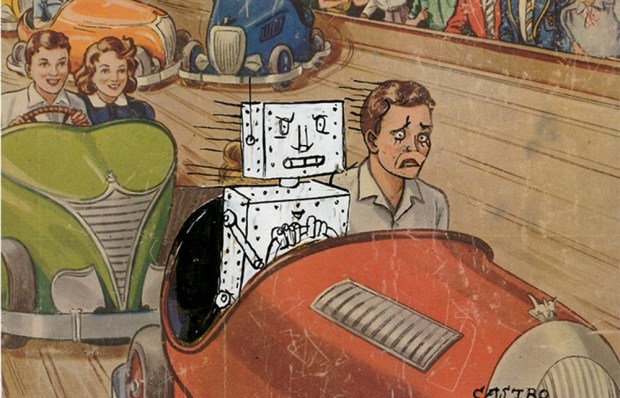A fascinating newcomer on the British high street is the vape shop. These were perfectly described by my friend Paul Craven as ‘like a cross between an Apple Store and an Elizabethan apoth-ecary’.
In the splendid All About da Vape in Deal, there is a glass cabinet full of new, hi-tech ‘mods’, ‘tanks’ and ‘coils’, while on rows of shelves behind the counter is a Cambrian explosion of coloured bottles containing e-liquid in many strengths and flavours, hipsterishly labelled Suicide Bunny, Jimmy the Juice Man or Miss Pennyworth’s Elixirs; I recently bought a bottle of something called Unicorn Puke.
Yet to anyone over 40 it all seems strangely familiar in a Proustian kind of way (and yes, a company called Bordo2 makes a flavoured Madeleine de Proust e-liquid — £12.99 for 20ml). The memories the shop brought back were of what a good tobacconist was like 30 years ago, when chaps still smoked pipes.
In a way, the whole vaping market has mutated in a way no one could have foreseen: rather than simply replacing cigarette smoking (sales of ‘cig-alike’ devices have peaked) the market has spontaneously reinvented pipe-smoking in electronic form.
Unlike cigarette-smoking, where a few huge brands dominated, the pipe-tobacco market was hugely fragmented (unless you smoked Clan or St Bruno, which nobody of any discernment did). Cigarette smokers had a repertoire of brands they would smoke in extremis, but pipe men were generally fiercely loyal to very few — which is what made old tobacconists’ shelves so magically varied. British pipe-smokers were also naturally insular because, once you left Blighty, all foreign pipe tobacco was unimaginably disgusting. The commonest French brand (St Claude, I think) was positively sulphurous.
All the old pipe-smoker behaviours are re-emerging. Always wearing a jacket (to carry your equipment); strongly divergent opinions on flavours; obsession with equipment and accoutrements; even the camaraderie between enthusiasts. When a friend was recently stopped at airport security because the X-ray had detected his device, the operator wanted to chat about his ‘mod’ — the modern equivalent of ‘I say, is that meerschaum a Dunhill White Spot?’
The reason the EU has a plan to ban these vastly superior devices and limit vaping to cig-alikes is to destroy the diversity of the e-cig market to make it easier to regulate: more cigarette-like and less pipe-like. This would be a disaster. Vaping belongs to an evolutionary category of innovation (see Matt Ridley’s new book, The Evolution of Everything) where variation and bottom-up selection create a solution which intentional design could never have achieved.
Had the e-cigarette been invented and patented by a pharmaceutical company and promoted by the government, it would have failed. Big Pharma would have called the device Niquo-Stop453, made it from plastic, packaged it in boring green and white and sold it in chemists’ shops. No bureaucrat or corporate lackey would have thought ‘What if we call it Unicorn Puke and sell it like a high-end electrical product?’ To smokers, switching to Niquo-Stop453 would have felt like a sad compromise: like being treated for a disease. Switching to Unicorn Puke feels like a choice.
There are many categories where enjoyment depends on variety. If Europe wants to rationalise our vaping industry, we should demand the same consistency of them. Rather than all those stupid varieties of wine, they should just stick to two variants — red and white; and instead of all those redundant cheese varieties they should stick to making Cheddar.
Got something to add? Join the discussion and comment below.
Get 10 issues for just $10
Subscribe to The Spectator Australia today for the next 10 magazine issues, plus full online access, for just $10.















Comments
Don't miss out
Join the conversation with other Spectator Australia readers. Subscribe to leave a comment.
SUBSCRIBEAlready a subscriber? Log in